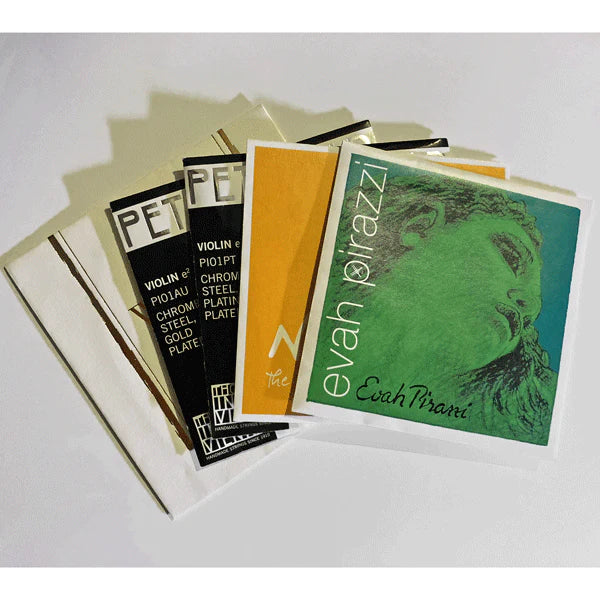
E String Comparison Set - Order a full set and compare all the major E string compositions for yourself.
Your choice of E string will affect the tone quality of your entire instrument, across all four strings. And, although there is a dizzying array of E string choices, there is a great deal of overlap across brands and manufacturers, with different sets having E strings of identical composition. So, for practical purposes, the selection can be reduced to a fairly small number of string types.
Tin-Plated E Strings
The standard choice for synthetic string sets, and the most popular all-around E string. Solid steel core with tin plating. Examples include Pirastro's Silvery Steel E used in Evah Pirazzi, Obligato, Violino, Aricore, Eudoxa, Passione, Passione Solo, Piranito, Pirastro Gold (Wondertone), Synoxa, Tonica, and Wondertone Solo sets. Thomastik's Vision, Vision Solo, Infeld Blue, and Peter Infeld (PI) sets also include a tin-plated E, as well as Thomastik's new Dominant Tinned E, Thomastik's Special E, and D'Addario's Helicore Plain Steel E.
 |
|
 |
|
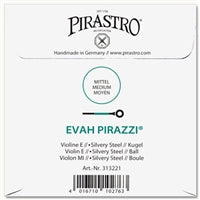
|
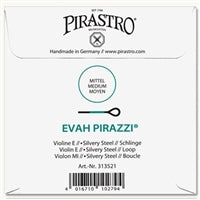
|
|
Plain Steel (Carbon Steel or Stainless Steel) E Strings
Simple, plain steel with no winding or plating. Plain steel E strings have a fat, strong tone with a bit of an edge, often favored by fiddlers. The playing characteristics vary however, with the quality of the steel. Steel with sufficient chromium content (above 10.5%) is termed stainless steel and is practically impervious to corrosion. Examples include Super Sensitive's Red Label E, Thomatik's Dominant Plain Steel E, Larsen's Plain Steel E, and Lenzner's Goldbrokat Steel E, the Hill Solo E, Pirastro's Chromcor E, and the E string from the new Evah Pirazzi Gold set. Note: When comparing strings, some manufacturers use the term "plain steel" to refer to tin-plated steel, so it can sometimes be hard to know what you're getting. Also, the term chrome steel (i.e. stainless steel) should not be confused with chrome-wound steel strings.
 |
|
 |
|

|

|
|
Aluminum-Wound E Strings
Due to their larger diameter, aluminum-wound strings are unlikely to whistle or squawk, and are consequently favored by beginners. They offer a slower response and a darker tone than most other E strings. Examples include: Thomastik's Dominant Wound E, D'Addario's Kaplan Non-Whistling E, and Pirastro's Tonica Wound E.
 |
|
 |
|
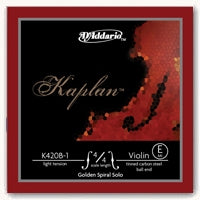
|
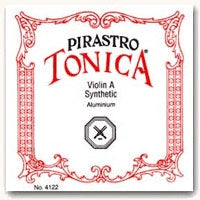
|
|
Gold-Plated E Strings
Gold-Plating imparts a warmth and richness to the tone, emphasizing the desirable overtones of the violin's voice. They are an excellent choice for advancing players seeking to improve the tone of their inexpensive instruments. However, they are particularly prone to whistling, wear out quickly, and are relatively expensive. Examples include gold-plated E strings from Pirastro's Evah Pirazzi, Obligato, and Oliv sets, as well as Thomastik's Peter Infeld Gold-Plated E.
 |
|
 |
|
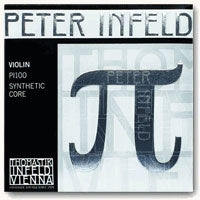
|

|
|
Other E Strings
Chrome-Wound E Strings
Prim strings, a perennial favorite among fiddlers, comes standard with a chrome-wound, steel core E. Pirastro's No. 1 Universal E String is also chrome-wound. Impervious to corrosion. Long lasting. Unlikely to whistle. Not recommended for use with synthetic sets, as the tone does not blend well across the strings.
Thomastik Peter Infeld Platinum-Plated E
Similar to gold-plated E strings, this platinum-plated E is even richer and more complex in tone. However, it also is prone to whistling, and has a very short life.
Warchal Amber Tin-Plated E String with Spring
This unique E has a spiral - a spring - build into the string. (The spring elongates and becomes almost straight under tension.) Warchal claims that this design makes the string more flexible and therefore improves the tone and eliminates whistling. Low tension.
Chorda Gut E
For authentic period instruments. Plain sheep gut. No knot. Not recommended for use with other sets.
Titanium-Plated E
Thomastik's Vision Titanium sets come with a titanium-plated E. Similar to tin-plated E in tone, this E has good projection, a brilliant tone, and a wide dynamic range. Titanium is less susceptible to corrosion than tin.
Gauges & Tensions
Most E strings, regardless of their construction, are available in different tensions (gauges). Heavy gauge strings require greater tension to bring up to pitch, and therefore tend to be more powerful. However, they are also have more mass, so they tend to be slower to respond. Gauges are not standard across all string sets, so a heavy gauge Evah Pirazzi E may be quite different from a heavy gauge Dominant.
Loop vs. Ball End E Strings

The E string must attach to the tailpiece of fine tuner in some fashion. Some E strings come with a ball end - a little brass circle, like the G, D, and A strings. These can be attached directly to the tailpiece (without a fine tuner) or to a suitable fine tuner. Certain types of fine tuners (Hill Style, for example) are designed to accept only loop end E strings.
In recent years, manufacturers have started making removable ball-end E strings. These come with the ball-type brass circle attached, but are designed so that it can be easily removed, should the player prefer to attach the string to a loop-end style fine tuner.
Some gut strings come with a knotend, which should be installed directly into the tailpiece, as with a ball-end string. Some gut strings come with a plain end, which must be knotted before installing.
